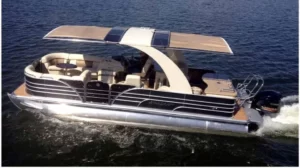An overview of driving a pontoon boat is provided below. We’ll go over the fundamentals for beginners. Let’s get started!
One of the simplest boats to learn to drive is a pontoon. I’m of the firm opinion that anyone who has driven a car can operate a pontoon boat. It’s much simpler in reality, though. If you ask the dealer when you purchase your boat, they will give you some introductory instructions. Additionally, there will be instructors for boating in your neighborhood.
But if you still want some pointers on how to drive a pontoon boat before you step onto one, then here’s a very good primer that will give you a massive head start with what you need to know with some basic controls and driving tips.
Before You Leave the Dock
Before getting started, keep in mind that all the rules and regulations that apply to operating a regular boat also apply to pontoon boats. This includes requirements for Coast Guard-approved flotation devices onboard the vessel.
Outboard motors, which are used on pontoon boats, must be warmed up. Check your owner’s manual to confirm that it usually takes between one and five minutes. Inspect your radio to make sure it’s in working order while the engine is warming up. It is crucial to ensure that you can send and receive transmissions because it is your emergency lifeline to land.
Also, make sure to secure any loose objects before you embark. During loading, it’s simple for backpacks, fishing rods, and other items to become dispersed. Ensure that everything is secured; otherwise, your preferred fishing rod might decide to take a bath.
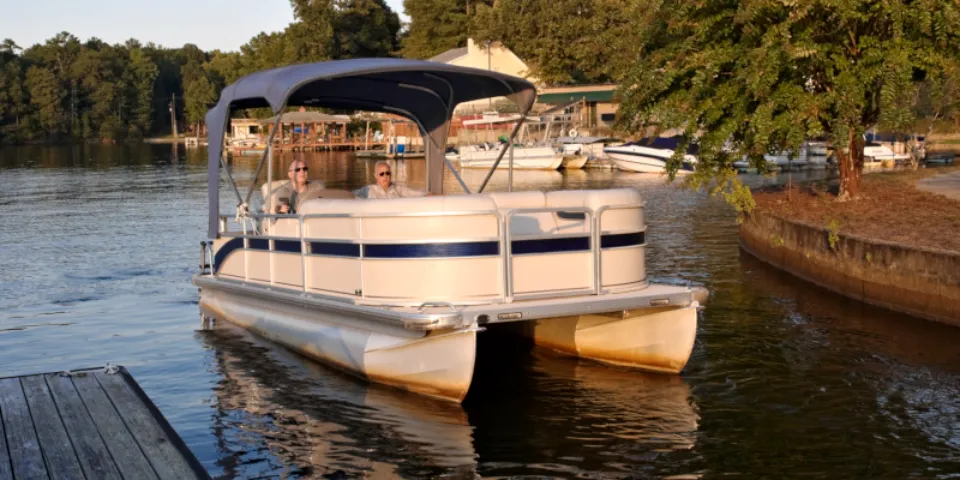
Another safety tip: Never, ever sit between the hulls in front of the deck rail. They risk being struck by the motor if they jump overboard because the boat will pass directly over them. These areas should only be used when the engine is off, even on boats with fishing decks forward of the rail.
How to Drive a Pontoon Boat?
If you’ve been boating your entire life, the body of water you are on should be your first priority before setting sail. Make sure you become familiar with any potentially relevant information for your location, such as shallow areas, the current, underwater obstacles that could be dangerous if you hit them, and so forth.
You must also be aware of all local, state, and federal laws that are relevant to the body of water you are boating on. Getting your boating license and completing a boaters safety course are two excellent ways to accomplish this.
Know Your Pontoon Boat
Once you are familiar with the terrain, check to see if you feel at ease using the pontoon boat. Even if you rode the boat on a demo ride before buying it, that doesn’t mean you understand how it works on your own.
Ask your dealer to conduct a test run with you and the boat if you haven’t yet taken delivery of the boat before you take it home. Make sure you know how to start the engine and go through the dashboard before asking someone to show you the various electronics.
Driving your new boat will be less stressful if you are familiar with its controls before your maiden voyage. Another important aspect is the safety features on board the pontoon.
Safety First
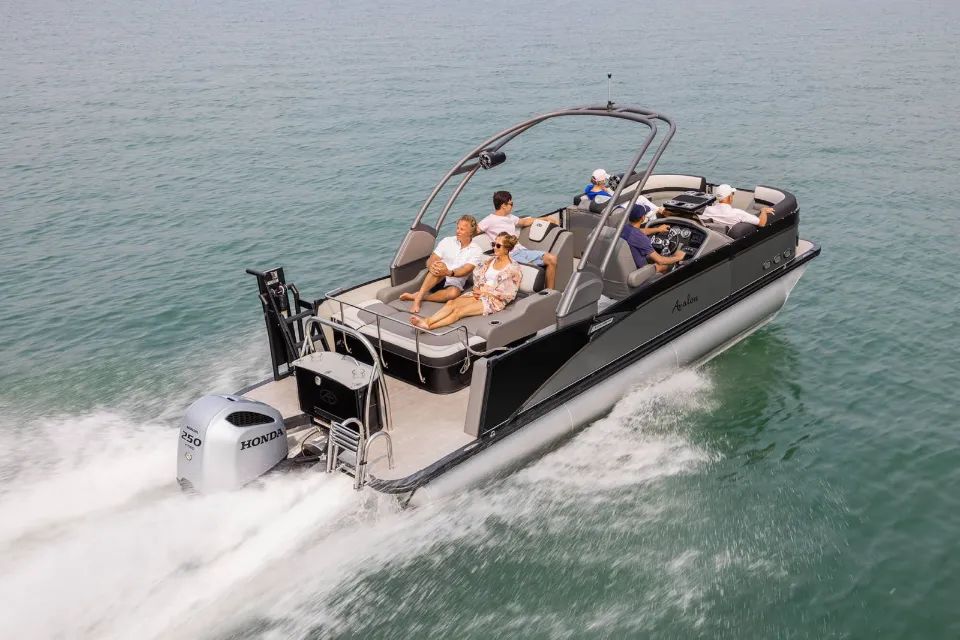
A fire extinguisher, a throwable flotation device, and, of course, enough life jackets for every person on the boat, to name a few, should always be kept on board. The US Coast Guard offers an app that will tell you what equipment you must have by law which I highly recommend downloading for reference.
It’s time to batten down the hatches and start moving if you feel comfortable on the water, have all of your safety gear with you, and are aware of the boating laws in your area. To prevent anything from flying off the boat when you take off, make sure all of your boat gear is firmly fastened in its designated location.
Turn the Motor On
Next, move over to the captain’s seat and flip the battery switch to the on position. Once seated, attach the emergency stop lanyard to your person. Usually, the emergency stop switch is where this lanyard is attached. It is bright red in color. Make sure the switch is flipped to “RUN”. See Where To Put A Trolling Motor On Your Pontoon Boat?
The motor should be trimmed down so that the propeller is in the water before starting the boat if it was stored with the motor fully out of the water. Turn on the engine and let it run after you’ve lowered the prop and adjusted the engine’s tilt to your desired level.
A couple of things to remember if the engine is not starting. For the boat to start, the throttle first needs to be in the neutral position. The engine will not start if the throttle is in gear. Also, make sure that the emergency stop switch is flipped all the way to “RUN”. The motor won’t turn on if the switch is not turned all the way. Check out What Size Trolling Motor for a Pontoon Boat?
Time to Cruise
Check your gauges after starting the boat. Ascertain that the temperature is controlled, the battery voltage is appropriate, and that you have enough fuel for your excursion. If all is good, it’s time to pull the dock lines. I hope you have a co-captain who will handle the push-off. If not, make sure to detach the emergency lanyard before getting up from your seat.
Pull away from the dock by moving the throttle out of neutral and forward slowly. Once you have cleared the dock, make sure you are aware of the speed restrictions and signage that lead to the open water.
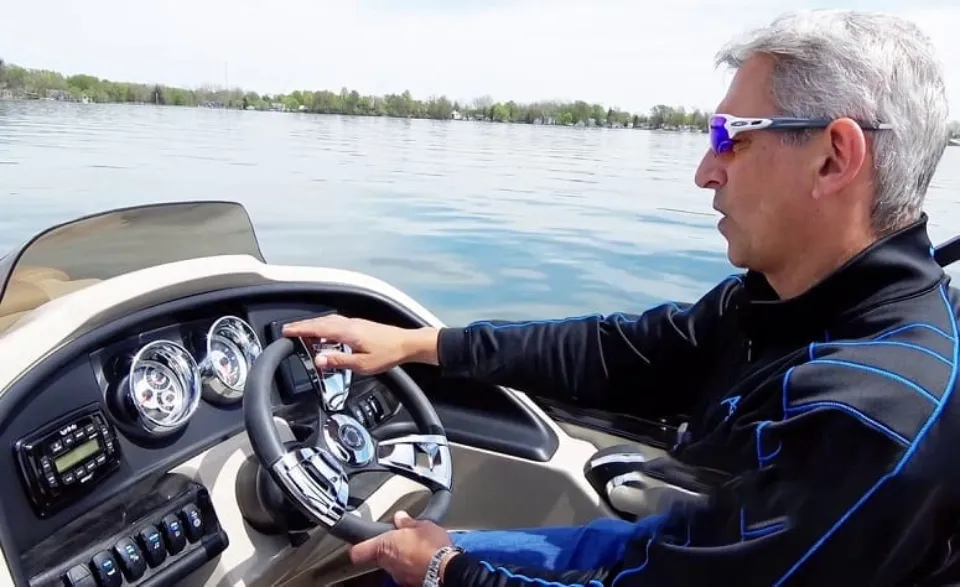
Motor Trim
Pontoon boats do not get on planes very well, meaning they don’t skim over the water surface like a single-hulled vessel. As a result, it doesn’t react much to motor trim.
In order to keep the prop shaft horizontal, it is best to leave the motor level. The motor is prevented from pushing the bow down and increasing drag, and the most effective power transfer is achieved. Furthermore, it maintains the prop in clear water, giving the boat a strong bite when turning and taking corners.
Returning to Dock
Before you need to slow down when heading back to the dock, release the gas. Boats can’t stop instantly as a sports car can. Although you can put the engine in reverse if necessary, stopping a boat successfully requires tact and patience. Learn How To Dock A Pontoon Boat?
Re-enter the dock exactly as you did when you first arrived. Use short bursts of throttle to ease your way closer, and use the motor and wheel to compensate for any wind gusts. In extremely windy conditions, having someone on the dock to throw a mooring line to can be useful. But ultimately, it’s all about being patient and finessing the boat into position to avoid damage and potential injury.
Two Tube Vs. Three Tube Handling
Both pontoon boats supported by two tubes and those supported by three tubes fall under the basic category of pontoon boats. On the water, each has a distinct personality.
Each tube of a set of twin-tube pontoons bears the weight of the boat equally. The boat will typically lean to the outside of the turn when turning quickly due to centrifugal force. A monohull responds in the exact opposite manner by leaning into a turn and carving through the water.
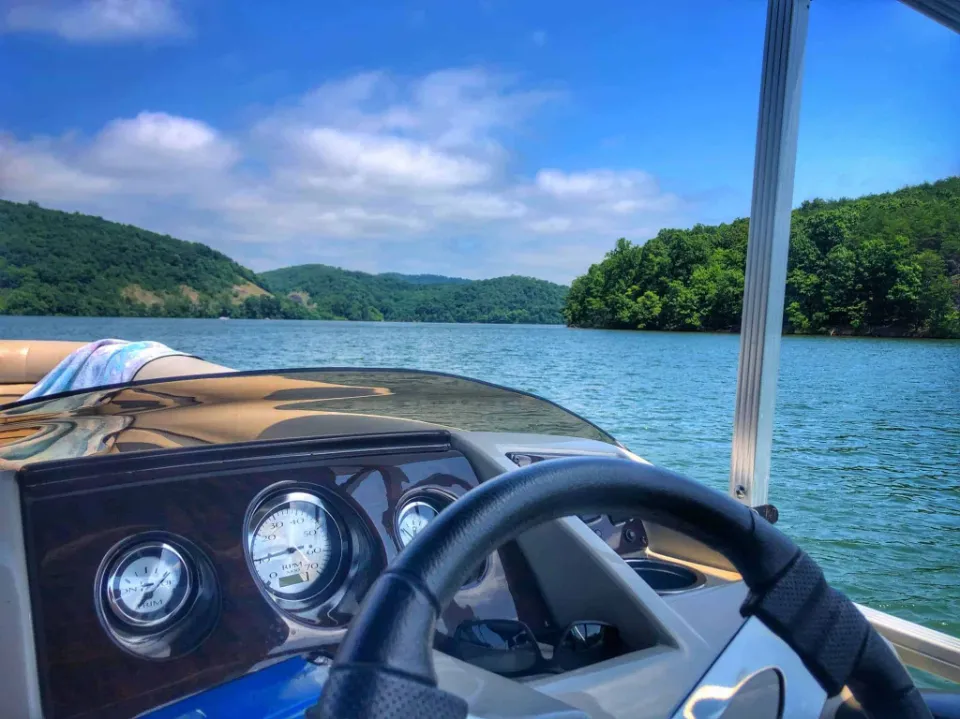
The twin-tube pontoon has a tendency to skid or slide slightly during the turn and isn’t really able to make a quick 90- or 180-degree turn at speed. Once you get a sense of the pontoon’s lack of agility, you can easily adjust by pre-planning maneuvers, allowing more space, and slowing down before a turn. In fact, slowing down frequently makes a boat’s direction change more effectively.
Numerous triple-tube pontoon boats are created to make up for this lack of agility. The center tube may have a slightly larger diameter than the outer tubes or it may be mounted a couple of inches lower. The goal is for the boat to be able to tip or lean onto the inner tube in either scenario when it is maneuvered into a turn. Passengers will be more comfortable as a result, and the boat will also be able to change directions more quickly.
In order to improve handling by lifting the entire boat and utilizing the energy of the spray coming off the tubes, pontoon boat builders also add rails or spray-deflecting devices along the length of the tubes. As a result, it is possible to make a triple-tube pontoon handle as a monohull approach with agility.
Conclusion: Drive a Pontoon Boat
Here are the steps to drive a pontoon boat:
- Know Your Pontoon Boat
- Safety First
- Turn the Motor On
- Time to Cruise
- Motor Trim
- Returning to Dock
When you are on the water, always follow your instincts and pay attention to your surroundings. Before you set out on your journey, make sure to choose your destination, keep an eye out for other boats and buoys, and keep up with the weather.
FAQs
How Does a Pontoon Boat Work?
Pontoon boats are flat-decked, recreational boats that rely on air-filled tubes called pontoons to achieve buoyancy in the water. For stability and buoyancy, traditional pontoons use a pair of pontoon tubes that are positioned on either side of the boat beneath the deck.
Are Pontoon Boats Good for Beginners?
In addition to having more space for families, pontoons are perfect for beginning boaters. They’re easy to drive and simple to dock because of the shape and speed of the boat. Pontoon boats are safe due to their size because it is challenging to flip or tip them.



